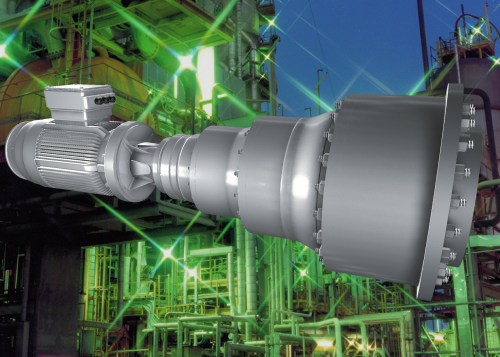

In the water industry peristaltic pumps are preferable for many applications. However, vibration, unbalanced loading and the need for high reduction ratios means that traditional transmissions are often too large, inefficient or prone to damage to function on larger pumps. A solution can be found in planetary gearboxes.
Peristaltic principlesThe principle of the peristaltic pump is based upon alternating compression and relaxation of the inner hose via two shoes positioned 180° apart on a rotor. As the rotor turns, the tube under compression closes thus forcing the fluid through the tube. Additionally, upon restitution of the hose, a vacuum develops which draws the fluid along the hose with no possibility of cross contamination. These pumps are capable of pumping liquid with up to 80% solid content.
The pumped liquid is totally contained within the hose so does not come into contact with any moving parts ensuring sterilization of the fluid, or indeed the pump. A gearbox with high torque and an ability to cope with out of balance radial loads is required to ensure the consistent operation of such pumps, especially those of the size used in the water industry.
In today’s climate, energy efficiency is also of utmost importance; especially when running a pump continuously. Brevini’s planetary gearboxes tackle this problem providing 98% energy efficiency per stage. As there are three planetary gears inside a toothed outer ring the load is spread among many contact points, this leads to less point pressure and less internal friction and more efficiency.
Other high reduction transmissions may have as low as 50% efficiency meaning a significant saving can be made. This efficiency means that a smaller motor is required which results in lower running costs for the pump overall.
In larger pumps and other water treatment processes it is necessary to move large rotors at low speeds. It is therefore essential that a high torque is achieved. Brevini’s planetary range provides torque from between 1.6 kNM to 800 kNM. The planetary gears create more contact points which means that the system is capable of maintaining the power without slipping.
While this kind of torque is possible with other gear systems, they will be up to twice the size and require a far larger motor to run them. The torque distribution of these systems means that they are more resistant to shock loading and provide rigidity.
Increasing flowrateMany gear systems are unreliable when used in a system with requirements similar to that of peristaltic pumps. Yorkshire Water’s Rawcliffe Sewage Treatment Works has the ability to process water at a flow rate of 23,600 m3/day. However, until they installed planetary gearboxes this maximum rate was impossible due to constant breakages.
Brevini’s gearboxes have been integrated into many water plants as, with features such as twin taper roller bearings and extremely high torque rates, they are capable of surviving in conditions where other transmissions fail.
The utilisation of the twin taper roller bearings, which can withstand extremely high radial loads, in the output of the gearbox allows the gearbox to be integrated into the casing by some OEM manufacturers. The gearbox is fitted with a double seal arrangement which can accommodate higher pressures thus ensuring that, when the hose needs replacing, the lubricant in the pump does not enter the gearbox.
The lifetime of a planetary gearbox can be up to 100,000 hours when it is in continuous use. The only routine maintenance required is oil changes, though even here less oil is required than with other conventional gearboxes. To ensure that the gearboxes will perform, their load capacity is calculated with a hertzian pressure and breaking strain in accordance with ISO DP6336 in relation to theoretical life. This offers engineers a benchmark for how long the system will operate.
In the unforeseen circumstance of a breakdown the modular construction of these planetary systems means that parts are held in stock. This reduces lead times from weeks to a matter of hours.
Planetary gearboxes are capable of high reduction rates meaning that a smaller input gear is required than with other transmission types. Brevini’s planetary gearbox’s are capable of reduction rates of 3-10:1. The addition of further stages can result in very high reduction (ratios can reach 15,000:1) whilst keeping the system relatively small.
Many users of large peristaltic pumps find that conventional gearboxes are far too cumbersome to be used effectively. These large gears require massive support structures to house them. Planetary gearboxes can be up to half the size and 60% lighter than conventional ‘worm and wheel’ gears. This smaller size means that a smaller support structure can be used which is ultimately easier to handle.
The smaller size means that planetary gearboxes offer solutions where other types are inoperative, for example they have been used to power aerators for Yorkshire Water’s Rawcliffe Sewage Treatment Works. The concept that ‘small and light’ can also mean ‘strong’ isn’t unique to water processing; other sectors including F1 technologies are realising this and using it to their advantage. These light weight and compact gearboxes offer a solution to operators of large pumps with limited space.
FlexibilityThe planetary design offers flexibility for solutions to any non-standard application. For example Brevini was the only company able to design a solution for Thames Water that complied with their ‘no engineering’ rule when an old gearbox broke, saving both down time and money. This flexibility is a great advantage for peristaltic pump users as each pump needs specific requirements, for example the planetary system is able to run clockwise and anti-clockwise and any standard motor can be direct mounted.
Peristaltic pumps continue to be preferable to water authorities. The introduction of a planetary gearbox system ensures that these pumps will run more efficiently with less maintenance.





